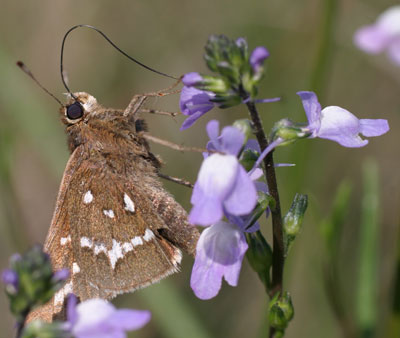Along a 30-mile stretch of the central N.C. coastline, what may be the rarest butterfly in the world is awakening from its winter slumber. To ward off the cold and wind, tiny green caterpillars had snuggled into the leaves of seaside little bluestem, a grass that grows in tufts amid the dunes of barrier islands.
The caterpillars were inactive through the winter and in a life stage called diapause, a state of dormancy in which all development is suspended. Unlike hibernation where development and metabolism still occur at a slower rate, during diapause all cellular growth stops.
Supporter Spotlight
As the days grew longer and warmer, the caterpillars began to feed on bluestem leaves before beginning the transformation into a type of butterfly called a skipper. By mid-April, a small fuzzy brown butterfly emerged and begin looking for some nectar.

A crystal skipper sips nectar from a toadflax bloom. Photo: Sam Bland |
Known scientifically as Atrytonopsis new species 1, this butterfly is being called the crystal skipper because of the crystal-like white shapes on its wings and because it is found nowhere in the world except the Crystal Coast. The butterfly lives along a thin stretch of beach from Bear Island in Hammocks Beach State Park in Onslow County to Fort Macon State Park at the eastern end of Bogue Banks in Carteret County, and on a few dredge spoil islands in between.
It was first documented in the late 1970s at Fort Macon. Since then biologists have
debated whether the insect is a distinct species or closely related to other similar skippers. Some biologists think that it is a subspecies of the abundant dusted skipper. Other scientists say its wing markings are a bit different and it has two flight seasons a year. The dusted skipper only has one. Could it be a subspecies of the rare loammi skipper? But those skippers live in a completely different habitat and lay their eggs on a different plant.
Supporter Spotlight
To settle the issue, the Smithsonian Institution is analyzing the DNA of the various skippers. The early results indicate that the crystal skipper could indeed be a separate species.
While the biologists debate and try to come to a consensus, the crystal skipper continues to hang out at the beach. As a skipper, the crystal skipper doesn’t have the flair and colorful markings of other butterflies. Due to its muted colors and hairy body, this small brown insect with white shapes on its wings is often mistaken for a moth and overlooked.
When it takes to the air in April and May, this skipper can be found primarily amid the primary and secondary sand dunes along the beach. It’s often found on the sound side of Bear Island where seaside little bluestem is abundant. They skip about in a fast and erratic flight pattern that at times makes them seem to disappear. They look for the sweet nectar of the southern dewberry or yellow thistle, which they will collect with their long proboscis.
Fortified with the energy-boosting nectar, the skippers go about the urgent business of looking for a mate. Since the adult butterfly lives for only a few days, there is little time for courting. After mating, the females lay eggs only on the blades of seaside little bluestem. Flying low to the ground, the females make quick pit stops on the outer blades laying only one white egg at a time.

A skipper caterpillar on a blade of bluestem. Photo: Sam Bland |
As they mature, the eggs develop a reddish tint, and eventually a pale green caterpillar with a black head hatches out. The caterpillars take on a reddish-brownish-purple color as they grow. That allows them to blend in among the bluestem leaves and to avoid detection by predators. The caterpillars graze on the tender bluestem leaves and by late July this new generation will have transformed into butterflies that now search for morning glory as their nectar source.
The largest populations of this butterfly are found on Bear Island, where the dune fields full of seaside little bluestem are protected from development. There is also a large population at Fort Macon State Park. However, pockets of the crystal skipper are also found throughout the developed areas of Bogue Banks wherever its habitat has not been destroyed.
Even though the skipper’s habitat has been fragmented along Bogue Banks, there’s enough bluestem scattered about to support populations of the insect. These smaller areas are needed to prevent the populations on Bear Island and at Fort Macon from becoming isolated, which would weaken the skipper’s gene pool.
Though it has yet to be scientifically described and officially classified, the skipper is distinct enough for the U.S. Fish and Wildlife Service to consider it a federal “species of concern.” This designation is an indication of how significantly the insect’s habitat has been destroyed and fragmented, but it provides no legal protection.
Some efforts are being made by the N.C. Aquarium and the N.C. Division of Coastal Management to improve and increase the seaside little bluestem grassland habitat at the Rachel Carson National Estuarine Research Reserve near Fort Macon State Park. If successful, this could create critical habitat and potentially expand the range of the skipper.
It is obvious that this shy little butterfly is living a fragile existence since much of its small range is developed and continues to be developed. The larger populations in the protected state parks could take a devastating blow with one monster hurricane.
Habitat protection, dune restoration and native landscaping are vital for the conservation of this dainty insect that could turn out to be one of the rarest butterflies in the world.







